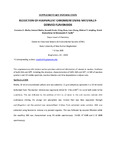Reduction of Hexavalent Chromium Using Naturally-Derived Flavonoids

View/
Date
2012Author
Okello, Veronica A.
Mwilu, Samuel
Noah, Naumih
Zhou, Ailing
Chong, Jane
Knipfing, Michael T.
Doetschman, David
Sadik, Omowunmi A.
Metadata
Show full item recordAbstract
Quercetin is a naturally occurring flavonoid that is known to form complexes with metals; a process that reduces the environmental availability of toxic metals such as chromium. We hereby report the first evidence of the removal of Cr(VI) from environmental samples using quercetin (QCR) and two synthetic derivatives: namely quercetin pentaphosphate (QPP) and quercetin sulfonic acid (QSA). We successfully synthesized both QPP and QSA using simple procedures while characterizing them with UV-vis spectroscopy, H1-NMR, 13C NMR, 31P-NMR, and LC-MS techniques. The solubility of QPP was found to be 840 mg/mL and aqueous solutions of both QPP and QSA were stable for over a period of 1 year. Quercetin and these derivatives were subsequently utilized for the reduction of Cr(VI) and QCR was found to have a higher reduction efficiency of 99.8% (30 min), followed by QPP/palladium nanoparticles mixture (PdNPs) at 96.5% (60 min), and finally QSA/PdNPs mixtures at 91.7% (60 min). PdNPs catalyst increased the efficiency by ∼36.5% while a change in operating temperature from 25 to 45 °C improved the efficiency by ∼46.8%. Electron paramagnetic resonance spectroscopy was used to confirm the presence of Cr (III) in the reaction products. This reduction approach was validated in environmental (Binghamton University) BU and standard reference material (BRS) soil samples. Results showed that the analysis could be completed within one hour and the efficiency was higher in BU soil than in BRS soil by 16.1%. QPP registered the highest % atom economy of 94.6%. This indicates enhanced performance compared to bioremediation approach that requires several months to achieve about 90% reduction efficiency.
